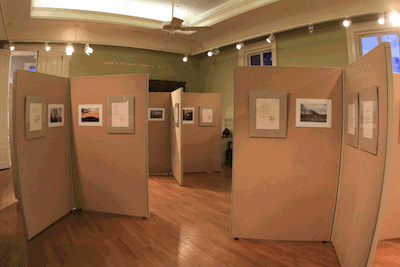March 4, 2016 | By Audrey Hall, The Daily Mississippian

Art on display for the “Mississippi” exhibit. |Photo by: Cameron Brooks/The Daily Mississippian
Mississippi is a beautiful state, blessed with dense forests and winding rivers. But Mississippi is also a state with a history of poverty, racial injustice and environmental damage. Nature has always been an important part of Mississippi’s culture, and this month the University of Mississippi is celebrating that relationship with a poem and photography exhibit, “Mississippi,” in Barnard Observatory’s Gammill Gallery. Poems from the University’s own Ann Fisher-Wirth, professor of English and director of the environmental studies minor, and photos by Mississippi-born photographer Maude Schuyler Clay stand side-by-side, portraying the nature and history of Mississippi as a place of enduring wonder and trials.
It was Clay’s suggestion that she and Fisher-Wirth might collaborate.
“It was Ann’s idea that I send her a few of my photographs that might inspire her to write some poems,” Clay said. “I sent a rather random group of images and she picked the ones she wanted to write poems about.”
The images are borne out of the Mississippi Delta, where Clay finds inspiration for her photography. Clay, whose family has been living in Sumner, Mississippi for five generations, moved to New York City after attending school at Ole Miss and the Memphis Academy of Arts. She was eventually drawn back to Mississippi, however, to raise a family.
“Even when living away all those years, my serious work was always done on trips back to the Mississippi Delta,” Clay said.
Fisher-Wirth said she agrees on the importance of place in this collaborative effort. “Mississippi” features poems only a page long, but they remain emblematic of nature and the problem of environmental decay.
“These poems are about the environmental history of this place,” she said. “They pay homage to the natural beauty of Mississippi and to the environmental decay that Mississippi has suffered. They’re fragmentary, with lots of white space, very experimental and non-conventional. I think they form a recognizable narrative, which fits the photography nicely.”
Fisher-Wirth said the poems are inspired by the photos.
“The poems are in voices,” Fisher-Wirth said. “They do not describe the photographs or represent them directly; rather, the voices came to me through my contact with the photographs. They are not about me, but the aspects of my experience and of the lives I have encountered during the 28 years I have lived in Mississippi are embedded throughout them. There’s one about a young mother, for instance — she isn’t me, but she comes to life through my own past experience.”
When talking about specific photographs and poems of which they are most proud, Fisher-Wirth and Clay agreed that those involving Emmett Till speak most poignantly.
“I really like them all, but I have to say the ones about the murderers of Emmett Till really hit home,” Clay said. “There is a lot of dark history here in Mississippi, and it is believed that the Emmett Till lynching kicked off the Civil Rights Movement.”
Fisher-Wirth, too, felt this was an important part of the exhibit.
“My poems focus on people of all backgrounds: rich and poor, old and young, African American and white, male and female, conservative and liberal, funny and heart-breaking,” said Fisher-Wirth. “The poems aren’t all political, but Civil Rights and ongoing racial issues play an important part in the sequence.”
A poem and photography collaboration focusing on the history and ecology of Mississippi is certainly a new idea, one that Fisher-Wirth and Clay have embraced.
“The collaboration of images and words has always intrigued me,” Clay said. “I don’t know that this combining of photos and words has been done before, beyond the late C. D Wright’s poems and Deborah Luster’s photographs. If there is a message it could be ‘Take a moment and look at the connections between words and pictures.’ With all the social media hurrying us along in this age, it’s important to make these connections.”
“Mississippi” promises a deeper perspective on the state we know, one deriving both from nature and from art. The exhibit opened Tuesday, March 1, and is open to the public. Fisher-Wirth and Clay will also host a Brown Bag reading, presentation and reception at 1 p.m. Wednesday, March 9 in Barnard Observatory.